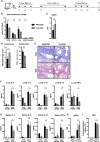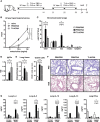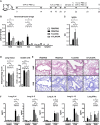Reduction of Allergic Lung Disease by Mucosal Application of Toxoplasma gondii-Derived Molecules: Possible Role of Carbohydrates
- PMID: 33776987
- PMCID: PMC7988086
- DOI: 10.3389/fimmu.2020.612766
Reduction of Allergic Lung Disease by Mucosal Application of Toxoplasma gondii-Derived Molecules: Possible Role of Carbohydrates
Abstract
Background: The hygiene hypothesis suggests a link between parasitic infections and immune disorders, such as allergic diseases. We previously showed that infection with Toxoplasma gondii or systemic application of T. gondii tachyzoites lysate antigen (TLA) in a prophylactic, but not therapeutic protocol, prevented allergic airway inflammation in mice. Here we tested the effect of prophylactic and therapeutic application of TLA via the mucosal route.
Methods: Mice were intranasally treated with TLA either i) prior to sensitization, ii) during sensitization and challenge, or iii) after sensitization with ovalbumin (OVA). Recruitment of inflammatory cells to the lung, cytokine levels in restimulated lung and spleen cell cultures as well as levels of OVA-specific antibodies in serum were measured. In parallel, the effect of native TLA, heat-inactivated (hiTLA) or deglycosylated TLA (dgTLA) on sensitized splenocytes was evaluated ex vivo.
Results: When applied together with OVA i) during systemic sensitization and local challenge or ii) exclusively during local challenge, TLA reduced infiltration of eosinophils into the lung, OVA-specific type 2 cytokines in restimulated lung cell cultures, and partially, type 2 cytokines in restimulated spleen cell cultures in comparison to allergic controls. No beneficial effect was observed when TLA was applied prior to the start of sensitization. Analysis of epitope sugars on TLA indicated a high abundance of mannose, fucose, N-acetylglucosamine, and N-acetylgalactosamine. Deglycosylation of TLA, but not heat-inactivation, abolished the potential of TLA to reduce type 2 responses ex vivo, suggesting a significant role of carbohydrates in immunomodulation.
Conclusion: We showed that mucosal application of TLA reduced the development of experimental allergy in mice. The beneficial effects depended on the timing of the application in relation to the time point of sensitization. Not only co-application, but also therapy in sensitized/allergic animals with native TLA reduced local allergic responses. Furthermore, we show that TLA is highly glycosylated and glycoconjugates seem to play a role in anti-allergic effects. In summary, given the powerful modulatory effect that TLA exhibits, understanding its exact mechanisms of action may lead to the development of novel immunomodulators in clinical application.
Keywords: Toxoplasma gondii; allergic airway inflammation; carbohydrates; deglycosylation; hygiene hypothesis; immunomodulation; parasites; tachyzoites lysate antigen.
Copyright © 2021 Korb, Drinić, Wagner, Geissler, Inic-Kanada, Peschke, Joachim, Wiedermann and Schabussova.
Conflict of interest statement
The authors declare that the research was conducted in the absence of any commercial or financial relationships that could be construed as a potential conflict of interest.
Figures







Similar articles
-
Toxoplasma gondii tachyzoite-extract acts as a potent immunomodulator against allergic sensitization and airway inflammation.Sci Rep. 2017 Nov 9;7(1):15211. doi: 10.1038/s41598-017-15663-4. Sci Rep. 2017. PMID: 29123241 Free PMC article.
-
Prime-boost vaccination with toxoplasma lysate antigen, but not with a mixture of recombinant protein antigens, leads to reduction of brain cyst formation in BALB/c mice.PLoS One. 2015 May 26;10(5):e0126334. doi: 10.1371/journal.pone.0126334. eCollection 2015. PLoS One. 2015. PMID: 26010355 Free PMC article.
-
Oocyst-Derived Extract of Toxoplasma Gondii Serves as Potent Immunomodulator in a Mouse Model of Birch Pollen Allergy.PLoS One. 2016 May 5;11(5):e0155081. doi: 10.1371/journal.pone.0155081. eCollection 2016. PLoS One. 2016. PMID: 27149118 Free PMC article.
-
Mechanisms of tolerance and allergic sensitization in the airways and the lungs.Curr Opin Immunol. 2010 Oct;22(5):616-22. doi: 10.1016/j.coi.2010.08.014. Epub 2010 Sep 29. Curr Opin Immunol. 2010. PMID: 20884192 Free PMC article. Review.
-
Tolerizing allergic responses in the lung.Mucosal Immunol. 2010 Jul;3(4):334-44. doi: 10.1038/mi.2010.19. Epub 2010 May 26. Mucosal Immunol. 2010. PMID: 20505664 Free PMC article. Review.
Cited by
-
Trichinella spiralis-derived extracellular vesicles induce regulatory T cells and reduce airway allergy in mice.Front Immunol. 2025 Jul 11;16:1637569. doi: 10.3389/fimmu.2025.1637569. eCollection 2025. Front Immunol. 2025. PMID: 40718495 Free PMC article.
References
Publication types
MeSH terms
Substances
LinkOut - more resources
Full Text Sources
Other Literature Sources
Medical

